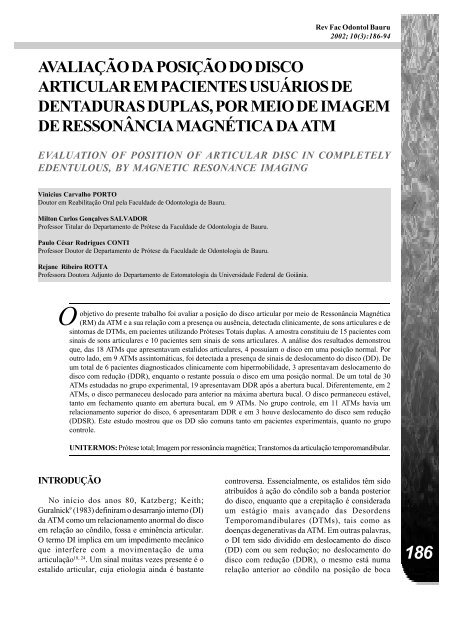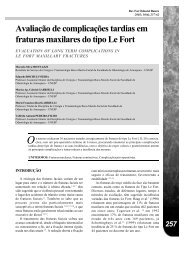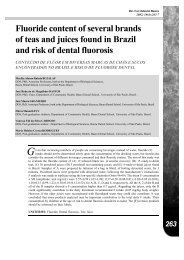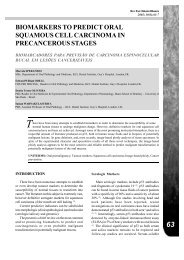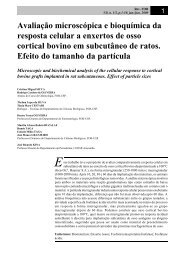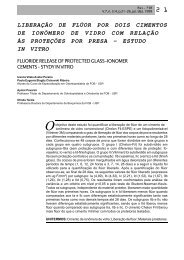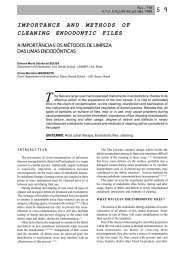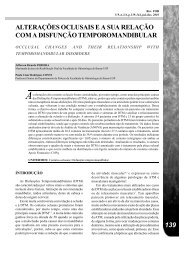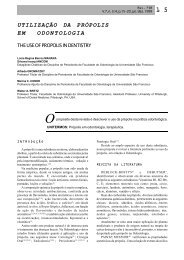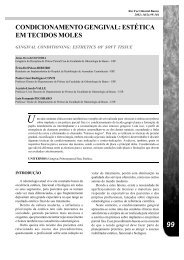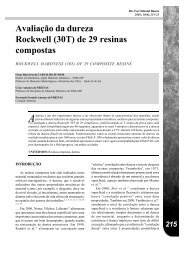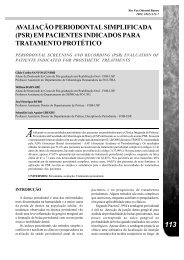avaliação da posição do disco articular em pacientes usuários de ...
avaliação da posição do disco articular em pacientes usuários de ...
avaliação da posição do disco articular em pacientes usuários de ...
Create successful ePaper yourself
Turn your PDF publications into a flip-book with our unique Google optimized e-Paper software.
Rev Fac O<strong>do</strong>ntol Bauru<br />
2002; 10(3):186-94<br />
AVALIAÇÃO DA POSIÇÃO DO DISCO<br />
ARTICULAR EM PACIENTES USUÁRIOS DE<br />
DENTADURAS DUPLAS, POR MEIO DE IMAGEM<br />
DE RESSONÂNCIA MAGNÉTICA DA ATM<br />
EVALUATION OF POSITION OF ARTICULAR DISC IN COMPLETELY<br />
EDENTULOUS, BY MAGNETIC RESONANCE IMAGING<br />
Vinicius Carvalho PORTO<br />
Doutor <strong>em</strong> Reabilitação Oral pela Facul<strong>da</strong><strong>de</strong> <strong>de</strong> O<strong>do</strong>ntologia <strong>de</strong> Bauru.<br />
Milton Carlos Gonçalves SALVADOR<br />
Professor Titular <strong>do</strong> Departamento <strong>de</strong> Prótese <strong>da</strong> Facul<strong>da</strong><strong>de</strong> <strong>de</strong> O<strong>do</strong>ntologia <strong>de</strong> Bauru.<br />
Paulo César Rodrigues CONTI<br />
Professor Doutor <strong>de</strong> Departamento <strong>de</strong> Prótese <strong>da</strong> Facul<strong>da</strong><strong>de</strong> <strong>de</strong> O<strong>do</strong>ntologia <strong>de</strong> Bauru.<br />
Rejane Ribeiro ROTTA<br />
Professora Doutora Adjunto <strong>do</strong> Departamento <strong>de</strong> Estomatologia <strong>da</strong> Universi<strong>da</strong><strong>de</strong> Fe<strong>de</strong>ral <strong>de</strong> Goiânia.<br />
O<br />
objetivo <strong>do</strong> presente trabalho foi avaliar a <strong>posição</strong> <strong>do</strong> <strong>disco</strong> <strong>articular</strong> por meio <strong>de</strong> Ressonância Magnética<br />
(RM) <strong>da</strong> ATM e a sua relação com a presença ou ausência, <strong>de</strong>tecta<strong>da</strong> clinicamente, <strong>de</strong> sons <strong>articular</strong>es e <strong>de</strong><br />
sintomas <strong>de</strong> DTMs, <strong>em</strong> <strong>pacientes</strong> utilizan<strong>do</strong> Próteses Totais duplas. A amostra constituiu <strong>de</strong> 15 <strong>pacientes</strong> com<br />
sinais <strong>de</strong> sons <strong>articular</strong>es e 10 <strong>pacientes</strong> s<strong>em</strong> sinais <strong>de</strong> sons <strong>articular</strong>es. A análise <strong>do</strong>s resulta<strong>do</strong>s d<strong>em</strong>onstrou<br />
que, <strong>da</strong>s 18 ATMs que apresentavam estali<strong>do</strong>s <strong>articular</strong>es, 4 possuíam o <strong>disco</strong> <strong>em</strong> uma <strong>posição</strong> normal. Por<br />
outro la<strong>do</strong>, <strong>em</strong> 9 ATMs assintomáticas, foi <strong>de</strong>tecta<strong>da</strong> a presença <strong>de</strong> sinais <strong>de</strong> <strong>de</strong>slocamento <strong>do</strong> <strong>disco</strong> (DD). De<br />
um total <strong>de</strong> 6 <strong>pacientes</strong> diagnostica<strong>do</strong>s clinicamente com hipermobili<strong>da</strong><strong>de</strong>, 3 apresentavam <strong>de</strong>slocamento <strong>do</strong><br />
<strong>disco</strong> com redução (DDR), enquanto o restante possuía o <strong>disco</strong> <strong>em</strong> uma <strong>posição</strong> normal. De um total <strong>de</strong> 30<br />
ATMs estu<strong>da</strong><strong>da</strong>s no grupo experimental, 19 apresentavam DDR após a abertura bucal. Diferent<strong>em</strong>ente, <strong>em</strong> 2<br />
ATMs, o <strong>disco</strong> permaneceu <strong>de</strong>sloca<strong>do</strong> para anterior na máxima abertura bucal. O <strong>disco</strong> permaneceu estável,<br />
tanto <strong>em</strong> fechamento quanto <strong>em</strong> abertura bucal, <strong>em</strong> 9 ATMs. No grupo controle, <strong>em</strong> 11 ATMs havia um<br />
relacionamento superior <strong>do</strong> <strong>disco</strong>, 6 apresentaram DDR e <strong>em</strong> 3 houve <strong>de</strong>slocamento <strong>do</strong> <strong>disco</strong> s<strong>em</strong> redução<br />
(DDSR). Este estu<strong>do</strong> mostrou que os DD são comuns tanto <strong>em</strong> <strong>pacientes</strong> experimentais, quanto no grupo<br />
controle.<br />
UNITERMOS: Prótese total; Imag<strong>em</strong> por ressonância magnética; Transtornos <strong>da</strong> articulação t<strong>em</strong>poromandibular.<br />
INTRODUÇÃO<br />
No início <strong>do</strong>s anos 80, Katzberg; Keith;<br />
Guralnick 9 (1983) <strong>de</strong>finiram o <strong>de</strong>sarranjo interno (DI)<br />
<strong>da</strong> ATM como um relacionamento anormal <strong>do</strong> <strong>disco</strong><br />
<strong>em</strong> relação ao côndilo, fossa e <strong>em</strong>inência <strong>articular</strong>.<br />
O termo DI implica <strong>em</strong> um impedimento mecânico<br />
que interfere com a movimentação <strong>de</strong> uma<br />
articulação 18, 24 . Um sinal muitas vezes presente é o<br />
estali<strong>do</strong> <strong>articular</strong>, cuja etiologia ain<strong>da</strong> é bastante<br />
controversa. Essencialmente, os estali<strong>do</strong>s têm si<strong>do</strong><br />
atribuí<strong>do</strong>s à ação <strong>do</strong> côndilo sob a ban<strong>da</strong> posterior<br />
<strong>do</strong> <strong>disco</strong>, enquanto que a crepitação é consi<strong>de</strong>ra<strong>da</strong><br />
um estágio mais avança<strong>do</strong> <strong>da</strong>s Desor<strong>de</strong>ns<br />
T<strong>em</strong>poromandibulares (DTMs), tais como as<br />
<strong>do</strong>enças <strong>de</strong>generativas <strong>da</strong> ATM. Em outras palavras,<br />
o DI t<strong>em</strong> si<strong>do</strong> dividi<strong>do</strong> <strong>em</strong> <strong>de</strong>slocamento <strong>do</strong> <strong>disco</strong><br />
(DD) com ou s<strong>em</strong> redução; no <strong>de</strong>slocamento <strong>do</strong><br />
<strong>disco</strong> com redução (DDR), o mesmo está numa<br />
relação anterior ao côndilo na <strong>posição</strong> <strong>de</strong> boca<br />
186
Porto V C, Salva<strong>do</strong>r M C G, Conti P C R, Rotta R R<br />
AVALIAÇÃO DA POSIÇÃO DO DISCO ARTICULAR EM PACIENTES USUÁRIOS DE DENTADURAS DUPLAS,<br />
POR MEIO DE IMAGEM DE RESSONÂNCIA MAGNÉTICA DA ATM<br />
187<br />
fecha<strong>da</strong>, retornan<strong>do</strong> à <strong>posição</strong> original durante a<br />
abertura bucal. Este fenômeno é caracteriza<strong>do</strong> por<br />
estali<strong>do</strong>s <strong>articular</strong>es. Quan<strong>do</strong> o <strong>disco</strong> falha no seu<br />
retorno à <strong>posição</strong> normal durante a abertura, a<br />
condição é <strong>de</strong>scrita como <strong>de</strong>slocamento <strong>do</strong> <strong>disco</strong><br />
para anterior s<strong>em</strong> redução (DDSR), não ocorren<strong>do</strong><br />
estali<strong>do</strong>s <strong>articular</strong>es 3 .<br />
A morfologia <strong>do</strong> <strong>disco</strong> t<strong>em</strong> si<strong>do</strong> consi<strong>de</strong>ra<strong>da</strong><br />
como um importante fator na ocorrência <strong>de</strong> DIs <strong>da</strong><br />
ATM, sen<strong>do</strong> portanto sugeri<strong>da</strong> como <strong>de</strong>terminante<br />
na limitação <strong>do</strong>s movimentos mandibulares e<br />
po<strong>de</strong>n<strong>do</strong> ser altera<strong>da</strong> <strong>em</strong> <strong>de</strong>trimento <strong>de</strong> um<br />
<strong>de</strong>slocamento condilar. Quan<strong>do</strong> este se apresenta<br />
para posterior, associa<strong>do</strong> com um <strong>de</strong>slocamento<br />
anterior <strong>do</strong> <strong>disco</strong>, po<strong>de</strong> provocar compressão <strong>da</strong> zona<br />
retrodiscal e induzir sintomatologia <strong>do</strong>lorosa, ten<strong>do</strong><br />
<strong>em</strong> vista que este teci<strong>do</strong> não foi <strong>de</strong>senvolvi<strong>do</strong><br />
primariamente para receber impactos <strong>de</strong> forma<br />
contínua. A tolerância ou não a estas cargas<br />
resultará <strong>em</strong> a<strong>da</strong>ptação ou lesão <strong>do</strong> teci<strong>do</strong><br />
retrodiscal, respectivamente.<br />
Portanto, torna-se <strong>de</strong> extr<strong>em</strong>a importância o<br />
estu<strong>do</strong> <strong>da</strong>s possíveis posições que o <strong>disco</strong> po<strong>de</strong><br />
ocupar <strong>em</strong> <strong>pacientes</strong> porta<strong>do</strong>res <strong>de</strong> próteses totais<br />
duplas, b<strong>em</strong> como <strong>da</strong>s outras estruturas <strong>da</strong> ATM;<br />
avaliar a <strong>posição</strong> <strong>do</strong> <strong>disco</strong> nos <strong>pacientes</strong> <strong>de</strong>s<strong>de</strong>nta<strong>do</strong>s<br />
totais; correlacionar as posições <strong>do</strong>s <strong>disco</strong>s<br />
encontra<strong>da</strong>s com os sinais obti<strong>do</strong>s por exame clínico<br />
e, <strong>de</strong>screver a intensi<strong>da</strong><strong>de</strong> <strong>de</strong> sinais, as alterações<br />
ósseas, a morfologia <strong>do</strong>s <strong>disco</strong>s <strong>articular</strong>es e o nível<br />
<strong>de</strong> translação condilar.<br />
MATERIAL E MÉTODOS<br />
Um total <strong>de</strong> 25 <strong>pacientes</strong> foram seleciona<strong>do</strong>s na<br />
clínica <strong>de</strong> Prótese Total, <strong>do</strong> Departamento <strong>de</strong><br />
Próteses Dentária, <strong>da</strong> Facul<strong>da</strong><strong>de</strong> <strong>de</strong> O<strong>do</strong>ntologia <strong>de</strong><br />
Bauru, Universi<strong>da</strong><strong>de</strong> <strong>de</strong> São Paulo. Dois grupos<br />
constituíram a amostra: o primeiro com 15 <strong>pacientes</strong><br />
apresentan<strong>do</strong> clinicamente sinais <strong>de</strong> sons <strong>articular</strong>es<br />
tipo estali<strong>do</strong> <strong>de</strong>tecta<strong>do</strong>s por meio <strong>de</strong> inspeção manual<br />
<strong>da</strong> ATM e, num segun<strong>do</strong> grupo, 10 <strong>pacientes</strong> livres<br />
<strong>de</strong> quaisquer sinais <strong>de</strong> sons <strong>articular</strong>es (grupo<br />
controle). Para a seleção <strong>do</strong>s grupos <strong>de</strong> trabalho, os<br />
seguintes critérios foram estabeleci<strong>do</strong>s: nenhum<br />
paciente <strong>de</strong>veria ter história prévia <strong>de</strong> tratamento<br />
com disfunção; os <strong>pacientes</strong> seleciona<strong>do</strong>s <strong>de</strong>viam<br />
fazer uso <strong>do</strong>s pares <strong>de</strong> <strong>de</strong>ntadura, s<strong>em</strong> levar <strong>em</strong><br />
consi<strong>de</strong>ração o seu t<strong>em</strong>po <strong>de</strong> uso; to<strong>do</strong>s os <strong>pacientes</strong><br />
<strong>de</strong>veriam ter uma abertura bucal mínima <strong>de</strong> 35mm<br />
conforme estabeleci<strong>do</strong> por Takaku; Sano; Yoshi<strong>da</strong> 21<br />
(2000) e Yoshi<strong>da</strong> et al. 30 (2000).<br />
Os <strong>pacientes</strong> foram submeti<strong>do</strong>s por um<br />
examina<strong>do</strong>r (examina<strong>do</strong>r 1) a um questionário sobre<br />
abor<strong>da</strong>gens anamnésicas, a um exame clínico<br />
dividi<strong>do</strong> <strong>em</strong> <strong>avaliação</strong> <strong>da</strong> ATM e exame muscular, e<br />
a um exame <strong>de</strong> Ressonância Magnética. Tais<br />
exames foram realiza<strong>do</strong>s por um examina<strong>do</strong>r que<br />
não teve participação na interpretação <strong>da</strong>s imagens<br />
por RM.<br />
Para a <strong>de</strong>terminação <strong>da</strong> máxima abertura bucal<br />
e <strong>do</strong>s movimentos laterais protrusivos, o examina<strong>do</strong>r<br />
1 utilizou-se <strong>de</strong> uma régua plástica gradua<strong>da</strong> <strong>em</strong><br />
milímetros, mensuran<strong>do</strong> a distância entre as bor<strong>da</strong>s<br />
incisais <strong>do</strong>s incisivos superiores e inferiores. Os<br />
limites <strong>de</strong> laterali<strong>da</strong><strong>de</strong> <strong>em</strong> um paciente <strong>de</strong>s<strong>de</strong>nta<strong>do</strong><br />
(<strong>em</strong> i<strong>da</strong><strong>de</strong> mais avança<strong>da</strong>) não são relata<strong>do</strong>s na<br />
literatura, ten<strong>do</strong> <strong>em</strong> vista a per<strong>da</strong> natural <strong>da</strong><br />
mobili<strong>da</strong><strong>de</strong>. Foi pedi<strong>do</strong> a to<strong>do</strong>s <strong>pacientes</strong> que<br />
realizass<strong>em</strong> o movimento <strong>de</strong> máxima abertura bucal<br />
por 3 vezes consecutivas enquanto o examina<strong>do</strong>r 1<br />
registrava os sons <strong>articular</strong>es. Se o som estava<br />
presente <strong>em</strong> <strong>do</strong>is <strong>do</strong>s movimentos <strong>de</strong> abertura e<br />
fechamento, registrou-se como um acha<strong>do</strong> positivo,<br />
<strong>de</strong> acor<strong>do</strong> com o que foi preconiza<strong>do</strong> por Orsini et<br />
al. 13 (1998,1999). To<strong>da</strong>s as imagens foram<br />
realiza<strong>da</strong>s no serviço <strong>de</strong> RM <strong>do</strong> Centro <strong>de</strong><br />
Diagnóstico <strong>de</strong> Imag<strong>em</strong>, <strong>em</strong> Bauru-SP, através <strong>do</strong><br />
aparelho Flexart <strong>da</strong> Toshiba com potência regula<strong>da</strong><br />
para 0,5 Tesla. A seqüência <strong>em</strong>prega<strong>da</strong> foi a<br />
parassagital oblíqua, pon<strong>de</strong>ra<strong>da</strong> <strong>em</strong> T1 com cortes<br />
<strong>de</strong> espessura <strong>de</strong> 3mm e “gap” <strong>de</strong> 0,3mm. O<br />
equipamento possui bobinas próprias para ATM e o<br />
filme utiliza<strong>do</strong> foi o Ektascan 100 IK <strong>da</strong> Ko<strong>da</strong>k com<br />
dimensões <strong>de</strong> 35 x 43cm (as imagens foram<br />
grava<strong>da</strong>s <strong>em</strong> fita magnética). A seqüência foi<br />
registra<strong>da</strong> <strong>em</strong> T1 com valores <strong>de</strong> 490 para TR, 15<br />
para TE, 90/180 para F4, 2,2 para NAQ e 12,0 x<br />
12,0cm para FOV. Foram registra<strong>da</strong>s toma<strong>da</strong>s <strong>de</strong><br />
boca fecha<strong>da</strong> <strong>em</strong> cortes sagitais (T1 e T2*) e cortes<br />
coronais (T1), b<strong>em</strong> como toma<strong>da</strong>s <strong>de</strong> boca aberta<br />
<strong>em</strong> cortes sagitais (T1 e T2*). O t<strong>em</strong>po para<br />
captação <strong>da</strong>s imagens sagitais T1 e T2 foi <strong>de</strong> 6’30’’<br />
e 5’08”, respectivamente, enquanto para as imagens<br />
coronais foi <strong>de</strong> 6’20”. Inicialmente, localiza<strong>do</strong>res<br />
axiais foram usa<strong>do</strong>s para estabelecer um plano<br />
sagital <strong>de</strong> orientação <strong>em</strong> relação ao longo eixo <strong>do</strong><br />
côndilo. Posteriormente, para a captação <strong>da</strong>s<br />
imagens sagitais e coronais, planos perpendiculares<br />
e paralelos ao longo eixo <strong>do</strong>s côndilos foram incidi<strong>do</strong>s,<br />
mostran<strong>do</strong> uma orientação oblíqua para a obtenção<br />
<strong>da</strong>s imagens. A manutenção <strong>da</strong> boca aberta foi<br />
<strong>de</strong>termina<strong>da</strong> pela inter<strong>posição</strong>, entre as <strong>de</strong>ntaduras,<br />
<strong>de</strong> silicona <strong>de</strong> con<strong>de</strong>nsação <strong>da</strong> marca Optosil. To<strong>da</strong>s<br />
as toma<strong>da</strong>s <strong>de</strong> imag<strong>em</strong> foram realiza<strong>da</strong>s no mesmo
Rev Fac O<strong>do</strong>ntol Bauru<br />
2002; 10(3):186-94<br />
equipamento, por uma única profissional <strong>da</strong> área<br />
médica <strong>de</strong>vi<strong>da</strong>mente instruí<strong>da</strong> quanto à necessi<strong>da</strong><strong>de</strong><br />
<strong>de</strong> visualização <strong>da</strong> cavi<strong>da</strong><strong>de</strong> <strong>articular</strong>, e foram<br />
diretamente acompanha<strong>da</strong>s pelo examina<strong>do</strong>r 1. Após<br />
os exames termina<strong>do</strong>s, foram seleciona<strong>do</strong>s os 3<br />
melhores cortes <strong>de</strong> ca<strong>da</strong> toma<strong>da</strong>, uma central, uma<br />
medial e outra lateral, tanto para boca aberta quanto<br />
para boca fecha<strong>da</strong>. As imagens foram avalia<strong>da</strong>s por<br />
um único examina<strong>do</strong>r (examina<strong>do</strong>r 2) previamente<br />
calibra<strong>do</strong>, com treinamento avança<strong>do</strong> <strong>em</strong> DTM. Os<br />
parâmetros avalia<strong>do</strong>s pelo examina<strong>do</strong>r foram:<br />
<strong>posição</strong> e redução <strong>do</strong> <strong>disco</strong> <strong>articular</strong>; morfologia <strong>do</strong><br />
<strong>disco</strong>, alteração <strong>de</strong> sinais, alterações ósseas e<br />
mobili<strong>da</strong><strong>de</strong> condilar.<br />
A presença <strong>de</strong> concavi<strong>da</strong><strong>de</strong>s, erosão e/ou<br />
osteófitos no côndilo, na fossa mandibular e/ou na<br />
<strong>em</strong>inência <strong>articular</strong> <strong>de</strong> ca<strong>da</strong> articulação foi<br />
consi<strong>de</strong>ra<strong>da</strong> <strong>do</strong>ença ósseo-<strong>de</strong>generativa (DOD). A<br />
aparência achata<strong>da</strong> ou aplaina<strong>da</strong> (s<strong>em</strong><br />
irregulari<strong>da</strong><strong>de</strong>s no córtex) <strong>do</strong>s componentes ósseos<br />
<strong>da</strong> articulação ou alterações morfológicas simétricas<br />
foram classifica<strong>da</strong>s como r<strong>em</strong>o<strong>de</strong>lação óssea. As<br />
alterações <strong>de</strong> sinais nas RMs são perceptíveis <strong>de</strong>vi<strong>do</strong><br />
a alterações vasculares por inflamação, ed<strong>em</strong>a intra<strong>articular</strong>,<br />
<strong>de</strong>generações <strong>do</strong> <strong>disco</strong>, po<strong>de</strong>n<strong>do</strong> resultar<br />
<strong>em</strong> diagnósticos diferencia<strong>do</strong>s <strong>do</strong> normal. A<br />
presença <strong>de</strong> sinais nos espaços <strong>articular</strong>es foi<br />
<strong>de</strong>scrita quan<strong>do</strong> pelo menos um <strong>do</strong>s espaços estava<br />
envolvi<strong>do</strong>. Foram consi<strong>de</strong>ra<strong>da</strong>s como alterações <strong>de</strong><br />
sinais, a redução <strong>de</strong>stes <strong>em</strong> T1 (R1) e <strong>em</strong> T2* (R2),<br />
b<strong>em</strong> como a sua intensificação <strong>em</strong> T1 (I1) e <strong>em</strong><br />
T2* (I2). A <strong>posição</strong> condilar <strong>em</strong> boca aberta foi<br />
dividi<strong>da</strong> <strong>em</strong> estágios: ausência <strong>da</strong> translação condilar<br />
(valor 0); translação aquém <strong>da</strong> <strong>em</strong>inência ou<br />
hipomobili<strong>da</strong><strong>de</strong> (valor 1); translação ao nível <strong>da</strong><br />
<strong>em</strong>inência (valor 2) e translação além <strong>do</strong> ápice <strong>da</strong><br />
<strong>em</strong>inência <strong>articular</strong> <strong>de</strong>nomina<strong>da</strong> hipermobili<strong>da</strong><strong>de</strong><br />
(valor 3).<br />
A partir <strong>de</strong>sta meto<strong>do</strong>logia <strong>em</strong>prega<strong>da</strong>, a relação<br />
côndilo-<strong>disco</strong>, assim como o contorno ósseo, foram<br />
utiliza<strong>do</strong>s para classificar os <strong>pacientes</strong> como: normal<br />
(N), com <strong>de</strong>slocamento <strong>do</strong> <strong>disco</strong> com redução<br />
(DDR), com <strong>de</strong>slocamento <strong>do</strong> <strong>disco</strong> s<strong>em</strong> redução<br />
(DDSR), e/ou com <strong>do</strong>ença ósseo <strong>de</strong>generativa<br />
(DOD). A <strong>posição</strong> anatômica será classifica<strong>da</strong> como<br />
superior (Normal), DD total anterior, DD parcial<br />
anterior no 1/3 lateral <strong>da</strong> articulação e DD parcial<br />
anterior no 1/3 medial <strong>da</strong> articulação, DD ânterolateral,<br />
DD ântero-medial, DD lateral, DD medial e<br />
DD posterior 23 . De acor<strong>do</strong> com o preconiza<strong>do</strong> por<br />
Tasaki 23 (1993), quan<strong>do</strong> o <strong>disco</strong> estava <strong>de</strong>sloca<strong>do</strong><br />
na <strong>posição</strong> <strong>de</strong> boca fecha<strong>da</strong> e retornou à <strong>posição</strong><br />
normal (superior) sobre o côndilo, <strong>em</strong> boca aberta,<br />
os <strong>pacientes</strong> foram classifica<strong>do</strong>s como porta<strong>do</strong>res<br />
<strong>de</strong> DDR. Quan<strong>do</strong> o <strong>disco</strong> permaneceu <strong>de</strong>sloca<strong>do</strong><br />
<strong>em</strong> relação à cabeça <strong>do</strong> côndilo na <strong>posição</strong> <strong>de</strong> boca<br />
aberta, os <strong>pacientes</strong> foram classifica<strong>do</strong>s como<br />
porta<strong>do</strong>res <strong>de</strong> DDSR. As imagens coronais foram<br />
<strong>em</strong>prega<strong>da</strong>s objetivan<strong>do</strong>-se compl<strong>em</strong>entar a <strong>posição</strong><br />
<strong>do</strong> <strong>disco</strong> <strong>articular</strong>. Neste plano, o <strong>disco</strong> foi<br />
classifica<strong>do</strong> como superior, medial ou lateral. A<br />
morfologia <strong>do</strong> <strong>disco</strong> foi avalia<strong>da</strong> nas articulações com<br />
ou s<strong>em</strong> DD e/ou DOD, na <strong>posição</strong> <strong>de</strong> boca aberta e<br />
boca fecha<strong>da</strong>. O <strong>disco</strong> bicôncavo foi consi<strong>de</strong>ra<strong>do</strong><br />
como forma normal. O aumento ou <strong>de</strong>formação <strong>da</strong>s<br />
ban<strong>da</strong>s <strong>do</strong> <strong>disco</strong> (biconvexo ou biplanar) também<br />
foi avalia<strong>do</strong>. Uma classificação in<strong>de</strong>termina<strong>da</strong> foi<br />
usa<strong>da</strong> para classificar to<strong>do</strong>s os <strong>disco</strong>s que não<br />
po<strong>de</strong>riam ser classifica<strong>do</strong>s como nenhum <strong>do</strong>s acima<br />
cita<strong>do</strong>s. A análise estatística foi basea<strong>da</strong> <strong>em</strong> méto<strong>do</strong>s<br />
<strong>de</strong>scritivos com valores absolutos e relativos. Para<br />
a comparação entre os grupos controle e<br />
experimental, foram utiliza<strong>do</strong>s os testes <strong>de</strong> Fisher e<br />
Qui-quadra<strong>do</strong>, a<strong>do</strong>tan<strong>do</strong>-se nível <strong>de</strong> significância <strong>de</strong><br />
5%.<br />
RESULTADOS<br />
De acor<strong>do</strong> com nosso trabalho, a i<strong>da</strong><strong>de</strong> <strong>do</strong>s<br />
<strong>pacientes</strong> seleciona<strong>do</strong>s variou <strong>de</strong> 41 a 81 anos, com<br />
média <strong>de</strong> 62,08 anos. Não houve valores<br />
estatisticamente significantes (p=0,8842;<br />
Spearman=0,030) <strong>de</strong> porcentag<strong>em</strong> <strong>de</strong> ocorrência <strong>de</strong><br />
DD <strong>em</strong> um <strong>de</strong>termina<strong>do</strong> grupo etário ou gênero<br />
(p=0,4382; c 2 =1,649), apesar <strong>de</strong> ter havi<strong>do</strong> uma maior<br />
porcentag<strong>em</strong> <strong>de</strong> DD nas mulheres (86,66%) <strong>do</strong> que<br />
nos homens (70%).<br />
A ocorrência <strong>de</strong> intensi<strong>da</strong><strong>de</strong> <strong>de</strong> sinais <strong>em</strong> T2*<br />
advin<strong>do</strong>s <strong>do</strong>s espaços <strong>articular</strong>es superior e inferior<br />
era s<strong>em</strong>elhante tanto <strong>em</strong> articulações com sons<br />
<strong>articular</strong>es quanto no grupo controle. Não foi possível<br />
fazer uma correlação estatística significativa<br />
(p=0,743; c 2 =0,743) entre o aumento <strong>de</strong> sinais <strong>do</strong>s<br />
espaços <strong>articular</strong>es e o diagnóstico <strong>da</strong> <strong>posição</strong> <strong>do</strong><br />
<strong>disco</strong> (Tabela 1). Observou-se uma intensificação<br />
<strong>de</strong> sinais <strong>em</strong> 26 (86,66%) <strong>da</strong>s 30 articulações com<br />
DD (DDR e DDSR), enquanto que <strong>em</strong> 16 (80%)<br />
<strong>da</strong>s 20 articulações s<strong>em</strong> <strong>de</strong>slocamento <strong>do</strong> <strong>disco</strong><br />
também foram encontra<strong>do</strong>s valores significativos <strong>de</strong><br />
aumento <strong>de</strong> sinais. As articulações diagnostica<strong>da</strong>s<br />
com aumento <strong>de</strong> sinais não tinham escores altos à<br />
palpação, tanto no aspecto posterior, quanto lateral<br />
<strong>da</strong> ATM. Não houve também uma diferença<br />
estatisticamente significante quanto à intensi<strong>da</strong><strong>de</strong> ou<br />
redução <strong>de</strong> sinais <strong>do</strong> <strong>disco</strong> <strong>articular</strong> (p=0,236, c 2 =1,40<br />
188
Porto V C, Salva<strong>do</strong>r M C G, Conti P C R, Rotta R R<br />
AVALIAÇÃO DA POSIÇÃO DO DISCO ARTICULAR EM PACIENTES USUÁRIOS DE DENTADURAS DUPLAS,<br />
POR MEIO DE IMAGEM DE RESSONÂNCIA MAGNÉTICA DA ATM<br />
TABELA 1- Número <strong>de</strong> articulações, com <strong>posição</strong> superior <strong>do</strong> <strong>disco</strong> ou com <strong>de</strong>slocamentos <strong>do</strong> <strong>disco</strong>, que apresentavam<br />
intensificação <strong>de</strong> sinais.<br />
Deslocamento <strong>do</strong> <strong>disco</strong> ‘ N o <strong>de</strong> articulações N o <strong>de</strong> ATMs c/ aumento <strong>de</strong> sinais<br />
Superior 20 16<br />
DDR 25 22<br />
DDSR 5 4<br />
189<br />
para I1; p=0,133, c 2 =2,26 para I2; p=0,400 para R2)<br />
e região medular <strong>do</strong> côndilo (p= 0,289 para R1;<br />
p=0,265 para R2; p=0,130 para I2), ao se comparar<br />
<strong>pacientes</strong> com sons <strong>articular</strong>es com o grupo controle.<br />
Verificou-se uma translação condilar ao nível <strong>da</strong><br />
<strong>em</strong>inência <strong>articular</strong> <strong>em</strong> 21 ATMs (42%); nas d<strong>em</strong>ais<br />
articulações, foi observa<strong>da</strong> uma translação além <strong>da</strong><br />
<strong>em</strong>inência <strong>em</strong> 7 (14%) ATMs e aquém <strong>da</strong> <strong>em</strong>inência<br />
<strong>em</strong> 19 (38%) articulações. Em 3 ATMs (6%), não<br />
houve translação condilar. Não se observou uma<br />
tendência para um <strong>de</strong>termina<strong>do</strong> DD, quan<strong>do</strong> havia<br />
uma translação condilar, verifican<strong>do</strong>-se uma relação<br />
estatisticamente insignificante entre a ocorrência <strong>de</strong><br />
translação condilar e <strong>de</strong> DD (p=0,511; c 2 =5,26).<br />
A morfologia <strong>do</strong> <strong>disco</strong> foi diagnostica<strong>da</strong> nas<br />
imagens <strong>de</strong> boca aberta. Nos <strong>pacientes</strong> <strong>do</strong> grupo<br />
controle, foram consi<strong>de</strong>ra<strong>da</strong>s normais ou bicôncavas<br />
11 (55%) articulações, sen<strong>do</strong> que nas outras 9 (45%)<br />
houve uma forma biconvexa ou in<strong>de</strong>termina<strong>da</strong>. Já<br />
no grupo sintomático, a configuração <strong>do</strong> <strong>disco</strong> teve<br />
a seguinte distribuição: 17 (56,66%) normais, 12<br />
(40%) biconvexos e 1 (3,33%) in<strong>de</strong>termina<strong>do</strong> (Figura<br />
1). Não se verificou uma relação estatisticamente<br />
significante entre as morfologias <strong>do</strong> <strong>disco</strong> e o grupo<br />
no qual o paciente se encontrava (p=0,615; c 2 =0,97).<br />
Na análise <strong>da</strong>s diferentes morfologias <strong>do</strong> <strong>disco</strong><br />
separa<strong>da</strong>mente e sua relação com o DD, apenas foi<br />
FIGURA 1- Número <strong>de</strong> articulações apresentan<strong>do</strong><br />
diferentes morfologias <strong>do</strong> <strong>disco</strong>, nos grupos controle e<br />
sintomático<br />
possível observar valor significativamente diferente<br />
quan<strong>do</strong> os <strong>disco</strong>s eram convexos, ou seja, a gran<strong>de</strong><br />
maioria <strong>de</strong>les (13) apresentava DDR (p=0,022;<br />
c 2 =11,43). Entretanto, observaram-se também ATMs<br />
com DDR s<strong>em</strong> alterações <strong>da</strong> sua configuração (12)<br />
(Tabela 2). Não houve associação <strong>da</strong> <strong>de</strong>formi<strong>da</strong><strong>de</strong><br />
<strong>do</strong> <strong>disco</strong> com <strong>de</strong>generação condilar ou com a<br />
<strong>em</strong>issão <strong>de</strong> altos sinais.<br />
Através <strong>do</strong>s cortes sagitais, foi possível i<strong>de</strong>ntificar<br />
16 (32%) articulações com algum grau <strong>de</strong> DOD,<br />
sen<strong>do</strong> a maioria localiza<strong>da</strong> nos côndilos <strong>do</strong>s <strong>pacientes</strong><br />
sintomáticos (8). Os números <strong>de</strong> ATMs normais e<br />
com r<strong>em</strong>o<strong>de</strong>lação óssea foram proporcionais <strong>em</strong><br />
ambos os grupos. Não houve uma maior prevalência<br />
<strong>de</strong> algum tipo <strong>de</strong> alteração óssea analisa<strong>da</strong> entre os<br />
2 grupos (p=0,234, c 2 =2,91 para a <strong>em</strong>inência;<br />
p=0,396, c 2 =1,85 para a fossa; p=0,370; c 2 =1,99 para<br />
a região medular <strong>do</strong> côndilo) (Tabela 3).<br />
A distribuição <strong>do</strong>s diversos tipos <strong>de</strong> DD e acha<strong>do</strong>s<br />
clínicos estão apresenta<strong>do</strong>s na tabela 4. O estali<strong>do</strong><br />
<strong>articular</strong> foi o acha<strong>do</strong> clínico mais comum (18<br />
ATMs), compara<strong>do</strong> com a crepitação e a<br />
hipermobili<strong>da</strong><strong>de</strong> (6 ATMs ca<strong>da</strong>). Um total <strong>de</strong> 9<br />
<strong>pacientes</strong> apresentavam leve grau <strong>de</strong> sensibili<strong>da</strong><strong>de</strong><br />
à palpação <strong>da</strong> ATM, sen<strong>do</strong> que 3 <strong>de</strong>stes<br />
bilateralmente. Apenas <strong>em</strong> 3 indivíduos, foi<br />
registra<strong>da</strong> uma maior sensibili<strong>da</strong><strong>de</strong> <strong>da</strong> ATM à<br />
palpação. Esta sensibili<strong>da</strong><strong>de</strong> não foi relaciona<strong>da</strong> ao<br />
tipo <strong>de</strong> DD e à intensificação <strong>de</strong> sinais. Os <strong>pacientes</strong><br />
possuíam uma máxima abertura bucal com média<br />
<strong>de</strong> 47,8mm, varian<strong>do</strong> <strong>de</strong> 37 a 66mm, enquanto a<br />
média <strong>do</strong>s movimentos excursivos mandibulares<br />
(protrusão, laterali<strong>da</strong><strong>de</strong> direita e esquer<strong>da</strong>) oscilou<br />
entre 4 e 11mm, com média <strong>de</strong> 6,05mm. Houve uma<br />
per<strong>da</strong> média <strong>da</strong> máxima abertura bucal <strong>de</strong> 2,8mm<br />
após a inserção <strong>da</strong> silicona <strong>de</strong> con<strong>de</strong>nsação.<br />
Observou-se que, <strong>da</strong>s 18 ATMs que apresentavam<br />
estali<strong>do</strong>s <strong>articular</strong>es, 4 (22,2%) possuíam o <strong>disco</strong> <strong>em</strong><br />
uma <strong>posição</strong> normal. Por outro la<strong>do</strong>, <strong>em</strong> 9 (45%)<br />
ATMs assintomáticas, foi <strong>de</strong>tecta<strong>da</strong> a presença <strong>de</strong><br />
sinais <strong>de</strong> DD. A relação <strong>do</strong>s <strong>pacientes</strong><br />
diagnostica<strong>do</strong>s clinicamente com hipermobili<strong>da</strong><strong>de</strong><br />
mostrou que 3 (50%) articulações estavam com<br />
DDR e outras 3 (50%) possuíam o <strong>disco</strong> <strong>em</strong> uma
Rev Fac O<strong>do</strong>ntol Bauru<br />
2002; 10(3):186-94<br />
<strong>posição</strong> normal. O exame clínico não obteve uma<br />
correlação estatisticamente significante com as<br />
imagens obti<strong>da</strong>s por RM (p=0,248; c 2 = 7,86). De<br />
um total <strong>de</strong> 30 ATMs estu<strong>da</strong><strong>da</strong>s no grupo sintomático,<br />
19 (63,33%) apresentavam DDR após a abertura<br />
bucal. Diferent<strong>em</strong>ente, <strong>em</strong> outras 2 (6,66%) ATMs,<br />
o <strong>disco</strong> permaneceu <strong>de</strong>sloca<strong>do</strong> para anterior na<br />
máxima abertura bucal. O <strong>disco</strong> permaneceu estável,<br />
tanto <strong>em</strong> fechamento quanto <strong>em</strong> abertura bucal, <strong>em</strong><br />
9 (30%) ATMs sintomáticas. No grupo controle, os<br />
valores foram os seguintes: <strong>em</strong> 11 (55%) ATMs<br />
havia um relacionamento superior <strong>do</strong> <strong>disco</strong>, <strong>em</strong> 6<br />
(30%) ocorreu um DDR e nas outras 3 (15%) houve<br />
um DDSR (Tabela 4).<br />
Do total <strong>de</strong> articulações com <strong>posição</strong> superior<br />
<strong>do</strong> <strong>disco</strong>, 11 (55%) eram <strong>do</strong> grupo controle e 9 (30%)<br />
<strong>do</strong> grupo sintomático. O DD para anterior foi<br />
diagnostica<strong>do</strong> <strong>em</strong> 4 (20%) articulações <strong>do</strong> grupo<br />
controle e <strong>em</strong> 5 (16,66%) <strong>do</strong> grupo sintomático.<br />
Foram diagnostica<strong>da</strong>s 8 ATMs com <strong>de</strong>slocamento<br />
rotacional, sen<strong>do</strong> 7 com DD ântero-lateral e 1 com<br />
DD ântero-medial. O <strong>de</strong>slocamento puramente<br />
lateral ocorreu <strong>em</strong> 11 articulações (10 no grupo<br />
sintomático e 1 no controle) e o <strong>de</strong>slocamento<br />
puramente medial ocorreu <strong>em</strong> apenas 1 ATM<br />
(sintomático). Tais diagnósticos não seriam<br />
<strong>de</strong>tectáveis s<strong>em</strong> os cortes coronais. Foi encontra<strong>do</strong><br />
1 DD parcial no 1/3 lateral <strong>da</strong> ATM (sintomático).<br />
Não foram vistos DD para posterior e DD parcial<br />
no 1/3 medial <strong>da</strong> ATM <strong>em</strong> nenhum <strong>do</strong>s <strong>do</strong>is grupos<br />
TABELA 2- Número <strong>de</strong> articulações, com <strong>posição</strong> superior <strong>do</strong> <strong>disco</strong> ou com <strong>de</strong>slocamentos <strong>do</strong> <strong>disco</strong>, que apresentavam<br />
as diferentes morfologias <strong>do</strong> <strong>disco</strong><br />
Morfologia <strong>do</strong> <strong>disco</strong><br />
Deslocamento <strong>do</strong> <strong>disco</strong><br />
Superior DDR DDSR<br />
Normal 15 12 1<br />
Biconvexa 3 13 3<br />
In<strong>de</strong>termina<strong>da</strong> 2 1<br />
TABELA 3- Número <strong>de</strong> articulações normais, r<strong>em</strong>o<strong>de</strong>la<strong>da</strong>s e com <strong>de</strong>generações ósseo-<strong>articular</strong>es presentes <strong>em</strong><br />
diferentes estruturas anatômicas, nos grupos controle e sintomático<br />
Estruturas<br />
anatômicas<br />
Alterações ósseas<br />
Controle<br />
Sintomático<br />
Normal R<strong>em</strong>o<strong>de</strong>la<strong>do</strong> DOD Normal R<strong>em</strong>o<strong>de</strong>la<strong>do</strong> DOD<br />
Eminência 15 5 0 17 10 3<br />
Fossa 16 4 0 20 8 2<br />
Côndilo 3 14 3 7 15 8<br />
TABELA 4- Número <strong>de</strong> articulações com acha<strong>do</strong>s clínicos positivos e negativos <strong>em</strong> relação ao <strong>de</strong>slocamento <strong>do</strong><br />
<strong>disco</strong><br />
Deslocamento <strong>do</strong> <strong>disco</strong><br />
Acha<strong>do</strong> clínico <strong>articular</strong><br />
S<strong>em</strong> som Estali<strong>do</strong> Crepitação Hipermobili<strong>da</strong><strong>de</strong><br />
Normal 11 4 2 3<br />
DDR 6 13 3 3<br />
DDSR 3 1 1 0<br />
190
Porto V C, Salva<strong>do</strong>r M C G, Conti P C R, Rotta R R<br />
AVALIAÇÃO DA POSIÇÃO DO DISCO ARTICULAR EM PACIENTES USUÁRIOS DE DENTADURAS DUPLAS,<br />
POR MEIO DE IMAGEM DE RESSONÂNCIA MAGNÉTICA DA ATM<br />
191<br />
FIGURA 2- Número <strong>de</strong> articulações <strong>do</strong>s grupos controle<br />
e sintomático com diferentes posições anatômicas <strong>do</strong><br />
<strong>disco</strong> <strong>articular</strong> on<strong>de</strong>: S- Superior; DTA- Deslocamento<br />
total anterior <strong>do</strong> <strong>disco</strong>; DPAL- Deslocamento parcial no<br />
1/3 lateral; DPAM- Deslocamento parcial no 1/3 medial;<br />
DL- Deslocamento lateral; DM- Deslocamento Medial;<br />
DP- Deslocamento Posterior<br />
DISCUSSÃO<br />
A influência <strong>do</strong> gênero na prevalência <strong>de</strong> DDs e<br />
DTMs t<strong>em</strong> si<strong>do</strong> pesquisa<strong>da</strong> <strong>de</strong>s<strong>de</strong> o início <strong>do</strong>s anos 70.<br />
Segun<strong>do</strong> os trabalhos iniciais, não há uma maior<br />
predileção <strong>de</strong> sinais <strong>de</strong> DTM <strong>em</strong> homens ou mulheres<br />
assintomáticos. Entretanto, estu<strong>do</strong>s mais recentes têm<br />
mostra<strong>do</strong> uma maior prevalência <strong>de</strong> sinais e sintomas,<br />
b<strong>em</strong> como <strong>de</strong> DDs, <strong>em</strong> mulheres tanto na i<strong>da</strong><strong>de</strong> juvenil<br />
quanto adulta 7, 16 . Assim também parece ocorrer nos<br />
<strong>pacientes</strong> sintomáticos, nos quais se observa maior<br />
freqüência <strong>de</strong> sintomatologia nas mulheres <strong>em</strong><br />
comparação aos homens, apresentan<strong>do</strong> proporções <strong>de</strong><br />
3:1 12 . Kircos et al. 10 (1987) verificaram uma<br />
porcentag<strong>em</strong> maior <strong>de</strong> DD <strong>em</strong> homens, entretanto, isto<br />
po<strong>de</strong> ter si<strong>do</strong> <strong>em</strong> <strong>de</strong>corrência <strong>do</strong> pequeno tamanho <strong>da</strong><br />
amostra. Em nosso trabalho, verificou-se uma leve<br />
tendência <strong>de</strong> DD <strong>em</strong> <strong>pacientes</strong> <strong>do</strong> gênero f<strong>em</strong>inino<br />
(86,66%), <strong>em</strong> relação aos <strong>do</strong> gênero masculino (70%);<br />
entretanto, s<strong>em</strong> diferenças estatisticamente<br />
significativas. A razão para uma maior ocorrência <strong>de</strong><br />
DD <strong>em</strong> mulheres permanece ain<strong>da</strong> obscura. Uma<br />
hipótese po<strong>de</strong> ser o fato <strong>da</strong>s mulheres procurar<strong>em</strong> mais<br />
prontamente o tratamento quan<strong>do</strong> estão <strong>do</strong>entes <strong>do</strong><br />
que os homens. Outra explicação, talvez mais plausível,<br />
é a ocorrência mais freqüente <strong>de</strong> lassidão ou<br />
frouxamento <strong>de</strong> ligamentos <strong>articular</strong>es <strong>de</strong> forma<br />
sistêmica <strong>em</strong> <strong>pacientes</strong> com DD <strong>do</strong> que <strong>em</strong> <strong>pacientes</strong><br />
assintomáticos ou com outros tipos <strong>de</strong> <strong>de</strong>sor<strong>de</strong>ns,<br />
associa<strong>da</strong> ao fato <strong>de</strong>ste frouxamento ligamentar ocorrer<br />
mais comumente <strong>em</strong> indivíduos <strong>do</strong> gênero f<strong>em</strong>inino.<br />
Este frouxamento po<strong>de</strong> ser oriun<strong>do</strong> <strong>da</strong> alteração <strong>do</strong><br />
metabolismo <strong>do</strong> colágeno, visto que altas proporções<br />
<strong>de</strong> colágeno tipo III e tipo I têm si<strong>do</strong> encontra<strong>da</strong>s <strong>em</strong><br />
<strong>pacientes</strong> com DD 16 . As DTMs têm si<strong>do</strong><br />
correlaciona<strong>da</strong>s com o aumento <strong>de</strong> prolapsos <strong>da</strong> válvula<br />
mitral entre os indivíduos, indican<strong>do</strong> a alteração <strong>do</strong><br />
metabolismo <strong>do</strong> colágeno como um possível fator<br />
etiológico para o frouxamento ligamentar.<br />
Existe um pico <strong>de</strong> incidência <strong>de</strong> DD <strong>em</strong> ATMs com<br />
sinais e sintomas <strong>de</strong> DTM durante a puber<strong>da</strong><strong>de</strong> 8 .<br />
Paesani et al. 14 (1999) mostraram que é mínima a<br />
probabili<strong>da</strong><strong>de</strong> <strong>de</strong> ocorrer DD no perío<strong>do</strong> <strong>do</strong>s 2 meses<br />
até os 5 anos <strong>de</strong> i<strong>da</strong><strong>de</strong>. Entre 8 e 15 anos, a prevalência<br />
tanto <strong>em</strong> indivíduos assintomáticos quanto sintomáticos<br />
foi <strong>de</strong> 6% 7 . A prevalência <strong>de</strong> DD, <strong>de</strong>formação <strong>do</strong><br />
<strong>disco</strong> e DOD <strong>em</strong> populações mais i<strong>do</strong>sas é maior <strong>do</strong><br />
que <strong>em</strong> jovens 5,15,28 . Provavelmente, processos<br />
<strong>de</strong>generativos nas ATMs estão fort<strong>em</strong>ente liga<strong>do</strong>s com<br />
o avanço <strong>da</strong> i<strong>da</strong><strong>de</strong>, com variações estruturais <strong>de</strong>vi<strong>do</strong> à<br />
osteoartrose, enquanto que os sinais e sintomas<br />
freqüent<strong>em</strong>ente diminu<strong>em</strong> 17 . A prevalência e<br />
severi<strong>da</strong><strong>de</strong> <strong>de</strong> alterações <strong>de</strong>generativas aumentam com<br />
o envelhecimento também <strong>em</strong> outras áreas <strong>do</strong> sist<strong>em</strong>a<br />
músculo-esquelético 8 . Em nosso trabalho, utilizan<strong>do</strong><br />
<strong>pacientes</strong> com i<strong>da</strong><strong>de</strong> entre 41 a 81 anos, não se observou<br />
predileção <strong>de</strong> DD <strong>em</strong> nenhuma faixa etária específica.<br />
A presença <strong>de</strong> sinais na região mais anterior <strong>da</strong><br />
ATM, especificamente nos espaços <strong>articular</strong>es superior<br />
18, 20,<br />
e inferior ao <strong>disco</strong>, têm si<strong>do</strong> discuti<strong>da</strong> na literatura<br />
25<br />
. O termo efusão <strong>articular</strong> t<strong>em</strong> si<strong>do</strong> aplica<strong>do</strong> à<br />
presença <strong>de</strong> altos sinais nestes espaços <strong>em</strong> pelo menos<br />
<strong>do</strong>is cortes consecutivos <strong>em</strong> RM 1 . Westesson; Brooks<br />
25<br />
(1992) encontraram uma forte associação entre<br />
efusão <strong>articular</strong> e <strong>pacientes</strong> com sintomatologia<br />
<strong>do</strong>lorosa. A porcentag<strong>em</strong> <strong>de</strong> <strong>pacientes</strong> com efusão foi<br />
maior nos estágios mais avança<strong>do</strong>s <strong>de</strong> DD <strong>do</strong> que nos<br />
estágios iniciais 1 . Nossa pesquisa revelou que não houve<br />
diferenças estatisticamente significantes <strong>em</strong> relação à<br />
<strong>em</strong>issão <strong>de</strong> sinais <strong>do</strong>s espaços <strong>articular</strong>es, tanto <strong>em</strong><br />
<strong>pacientes</strong> sintomáticos quanto no grupo controle. Este<br />
aumento <strong>de</strong> sinais po<strong>de</strong> ser proveniente tanto <strong>de</strong><br />
processos inflamatórios que faz<strong>em</strong> aumentar a<br />
concentração <strong>de</strong> prótons <strong>de</strong> hidrogênio, quanto <strong>do</strong><br />
aumento <strong>da</strong> quanti<strong>da</strong><strong>de</strong> <strong>de</strong> proteoglicanas e água. Não<br />
houve uma relação entre a sensibili<strong>da</strong><strong>de</strong> à palpação<br />
nos aspectos lateral e posterior <strong>da</strong> ATM e a<br />
intensificação <strong>de</strong> sinais nas RMs, <strong>em</strong> nosso trabalho.<br />
O significa<strong>do</strong> real <strong>do</strong> aumento <strong>de</strong> sinais no <strong>disco</strong> <strong>articular</strong><br />
ain<strong>da</strong> é <strong>de</strong>sconheci<strong>do</strong>. As áreas <strong>de</strong> hipersinal <strong>do</strong> <strong>disco</strong><br />
(ban<strong>da</strong> posterior) pod<strong>em</strong> ser sugestivas <strong>de</strong> um aumento<br />
<strong>de</strong> proteoglicanas 19 . Outro acha<strong>do</strong> com diagnóstico<br />
subjetivo foi a intensificação ou redução <strong>de</strong> sinais na
Rev Fac O<strong>do</strong>ntol Bauru<br />
2002; 10(3):186-94<br />
região medular <strong>do</strong> côndilo. O aumento <strong>de</strong> sinais <strong>em</strong> T1<br />
sugere a presença <strong>de</strong> ed<strong>em</strong>a <strong>articular</strong>, assim como a<br />
redução, <strong>em</strong> T1 e T2, seria compatível com necrose<br />
avascular.<br />
A alteração <strong>da</strong> morfologia <strong>do</strong> <strong>disco</strong> po<strong>de</strong> resultar<br />
<strong>em</strong> DIs <strong>da</strong> ATM e agir como causa <strong>do</strong> impedimento<br />
funcional <strong>articular</strong>. A <strong>de</strong>formação <strong>do</strong> <strong>disco</strong> po<strong>de</strong> estar<br />
relaciona<strong>da</strong> com <strong>pacientes</strong> DDSR e, ao mesmo t<strong>em</strong>po,<br />
a configuração normal <strong>do</strong> <strong>disco</strong> (forma <strong>de</strong> gravata<br />
borboleta) pareceu variar como resulta<strong>do</strong> <strong>do</strong>s diferentes<br />
<strong>de</strong>slocamentos <strong>articular</strong>es 24 . Segun<strong>do</strong> Yilmaz 29 (2001),<br />
quanto mais avança<strong>do</strong> for o DI, mais <strong>de</strong>teriora<strong>da</strong> estará<br />
a configuração <strong>do</strong> <strong>disco</strong>. Westesson; Bronstein;<br />
Liedberg 24 (1985) também afirmaram que raramente<br />
a <strong>de</strong>formação <strong>do</strong>s <strong>disco</strong>s é encontra<strong>da</strong> quan<strong>do</strong> este se<br />
apresenta numa <strong>posição</strong> normal e que o tratamento<br />
mais correto, <strong>em</strong> indivíduos sintomáticos com DI, seria<br />
a tentativa <strong>de</strong> diminuir a possibili<strong>da</strong><strong>de</strong> <strong>de</strong><br />
estabelecimento <strong>da</strong> <strong>de</strong>formação <strong>do</strong> <strong>disco</strong>. Em estu<strong>do</strong><br />
realiza<strong>do</strong> <strong>em</strong> espécimes necropsia<strong>da</strong>s, constatou-se que<br />
uma <strong>posição</strong> anterior <strong>do</strong> <strong>disco</strong> é uma condição que<br />
geralmente prece<strong>de</strong> a sua <strong>de</strong>formação 27 . Segun<strong>do</strong><br />
Westesson; Bronstein; Liedberg 24 (1985), a <strong>de</strong>formação<br />
<strong>do</strong> <strong>disco</strong>, assim como a sua <strong>posição</strong>, são <strong>de</strong>pen<strong>de</strong>ntes<br />
<strong>do</strong> plano <strong>de</strong> tratamento instituí<strong>do</strong>. Revelaram, ain<strong>da</strong>,<br />
que informações sobre a <strong>de</strong>formação <strong>do</strong> <strong>disco</strong> facilitarão<br />
o planejamento <strong>do</strong> tratamento cirúrgico, tanto numa<br />
eventual re<strong>posição</strong> quanto na possível r<strong>em</strong>oção. Houve,<br />
<strong>em</strong> nossas observações, uma relação estatisticamente<br />
significante entre morfologia <strong>do</strong> <strong>disco</strong> biconvexa e o<br />
DDR com boca aberta (p=0,022; c 2 =11,43). Portanto,<br />
nós pod<strong>em</strong>os afirmar que <strong>de</strong>formação <strong>do</strong> <strong>disco</strong> t<strong>em</strong><br />
uma tendência para ocorrer <strong>em</strong> articulações com DD.<br />
Dos 19 <strong>disco</strong>s com morfologia biconvexa, 16 (84%)<br />
apresentaram DDR ou DDSR.<br />
Por muitos anos, acreditava-se que o DD fosse a<br />
causa principal para o estabelecimento <strong>da</strong>s DTMs, com<br />
trabalhos tentan<strong>do</strong> reposicionar o <strong>disco</strong> para uma <strong>posição</strong><br />
consi<strong>de</strong>ra<strong>da</strong> mais a<strong>de</strong>qua<strong>da</strong> <strong>de</strong>ntro <strong>da</strong> ATM 6, 11 . A maior<br />
discussão <strong>do</strong>s trabalhos, avalian<strong>do</strong> a ATM por meio <strong>de</strong><br />
RM, recai sobre a proporção <strong>de</strong> <strong>disco</strong>s <strong>de</strong>sloca<strong>do</strong>s <strong>em</strong><br />
indivíduos sintomáticos e assintomáticos. Estu<strong>do</strong>s <strong>em</strong><br />
<strong>pacientes</strong> sintomáticos encontraram uma alta<br />
prevalência <strong>de</strong> DD 14, 16 . Os valores percentuais <strong>de</strong><br />
DD oscilam <strong>em</strong> números eleva<strong>do</strong>s <strong>de</strong> prevalência, tais<br />
como 78% 14 , 82% 22 , 76% 16 e 95% 12 <strong>em</strong> indivíduos<br />
sintomáticos, e 33% 12 , 32% 10 , 30% 22 , 15% 26 , 34%<br />
16<br />
<strong>em</strong> indivíduos assintomáticos. Os valores <strong>de</strong> DD<br />
encontra<strong>do</strong>s neste presente trabalho foram maiores <strong>em</strong><br />
<strong>pacientes</strong> sintomáticos (70%) quan<strong>do</strong> compara<strong>do</strong>s com<br />
o grupo controle (45%). Confirmou-se, porém, que DD<br />
<strong>em</strong> indivíduos assintomáticos é um acha<strong>do</strong> comum.<br />
Consi<strong>de</strong>ran<strong>do</strong> a amostra total (50 ATMs) como um<br />
único grupo assintomático <strong>em</strong> relação à <strong>do</strong>r, a<br />
porcentag<strong>em</strong> <strong>de</strong> DD foi significante, ou seja, <strong>de</strong> 60%<br />
(30 ATMs). Em populações assintomáticas, o estali<strong>do</strong><br />
<strong>articular</strong> t<strong>em</strong> ocorri<strong>do</strong> <strong>em</strong> aproxima<strong>da</strong>mente 30 a 50%<br />
e, mesmo assim, a maioria <strong>do</strong>s <strong>pacientes</strong> está isento <strong>de</strong><br />
sintomas. O DD não necessariamente causa <strong>do</strong>r 6 . A<br />
presença <strong>de</strong> DD para anterior não po<strong>de</strong> ser suficiente<br />
para se <strong>de</strong>terminar uma DTM, mas po<strong>de</strong> aumentar o<br />
risco <strong>de</strong> seu estabelecimento. As possíveis explicações<br />
para as diferenças entre nossos resulta<strong>do</strong>s e os outros<br />
estu<strong>do</strong>s estão nos critérios <strong>de</strong> seleção que foram<br />
utiliza<strong>do</strong>s e nos meios <strong>de</strong> diagnósticos <strong>em</strong>prega<strong>do</strong>s para<br />
a interpretação <strong>da</strong>s imagens. Nós <strong>em</strong>pregamos RMs,<br />
ao invés <strong>de</strong> artrografias ou TC , s.<br />
A precisão e correlação <strong>do</strong> exame clínico t<strong>em</strong> si<strong>do</strong><br />
questiona<strong>da</strong> quanto à real capaci<strong>da</strong><strong>de</strong> <strong>de</strong> reprodução<br />
<strong>de</strong> <strong>de</strong>talhes <strong>da</strong> ATM que propicie ao profissional a<br />
possibili<strong>da</strong><strong>de</strong> <strong>de</strong> um correto diagnóstico. Cholitgul et<br />
al. 2 (1997) <strong>de</strong>screveram que aqueles <strong>pacientes</strong> que<br />
possuíam sinais e sintomas <strong>de</strong> DTMs, tais como <strong>do</strong>res<br />
e sons <strong>articular</strong>es, tinham imagens compatíveis com<br />
DD. O exame clínico mostrou-se bastante eficiente<br />
na i<strong>de</strong>ntificação <strong>de</strong> DTMs, numa comparação com<br />
exames obti<strong>do</strong>s por RMs <strong>em</strong> <strong>pacientes</strong> que iriam se<br />
submeter a tratamento ortodôntico 7 . Da<strong>da</strong> a associação<br />
existente entre exame clínico e o diagnóstico final,<br />
parece apropria<strong>do</strong> que, ao menos por situações<br />
específicas tais como planejamento cirúrgico ou uma<br />
correlação <strong>de</strong> sintomatologia <strong>do</strong>lorosa, <strong>pacientes</strong> com<br />
suspeita <strong>de</strong> DD não necessariamente têm que estar<br />
sujeitos a imagens sofistica<strong>da</strong>s, procedimentos invasivos<br />
ou dispositivos <strong>de</strong> trajetórias mandibulares.<br />
É sabi<strong>do</strong> que n<strong>em</strong> to<strong>do</strong>s os <strong>pacientes</strong> com DDR<br />
necessariamente avançam para DDSR e que n<strong>em</strong> to<strong>do</strong>s<br />
os <strong>pacientes</strong> com DDSR evolu<strong>em</strong> para DOD, b<strong>em</strong><br />
como tanto <strong>pacientes</strong> com DDR e DDSR pod<strong>em</strong><br />
apresentar sinais <strong>de</strong> DOD. Já Cholitgul et al. 2 (1997)<br />
mostraram que osteófitos foram mais comumente<br />
encontra<strong>do</strong>s <strong>em</strong> articulações com DDSR; porém isto<br />
não implica que to<strong>da</strong>s as articulações com DDSR irão<br />
<strong>de</strong>senvolver DOD 5 . De Mot; Casselman; Deboeber 5<br />
encontraram DOD não somente <strong>em</strong> <strong>pacientes</strong> i<strong>do</strong>sos,<br />
mas também <strong>em</strong> <strong>pacientes</strong> jovens com i<strong>da</strong><strong>de</strong>s varian<strong>do</strong><br />
entre 10 e 20 anos. Ribeiro et al. 16 (1997) encontraram<br />
altos índices tanto <strong>de</strong> DD quanto <strong>de</strong> DOD, <strong>em</strong> crianças.<br />
De acor<strong>do</strong> com nossa pesquisa, não pod<strong>em</strong>os afirmar<br />
que há uma prevalência <strong>de</strong> DOD <strong>em</strong> <strong>pacientes</strong> i<strong>do</strong>sos.<br />
Das 150 avaliações <strong>da</strong>s estruturas anatômicas <strong>da</strong> ATM,<br />
observou-se que <strong>em</strong> 16 (10,6%) <strong>de</strong>las houve o<br />
diagnóstico <strong>de</strong> DOD. Há uma correlação na literatura<br />
entre DOD e DD, sugerin<strong>do</strong> que a DOD po<strong>de</strong> ser o<br />
resulta<strong>do</strong> <strong>do</strong> DD 9, 27 . Por outro la<strong>do</strong>, estu<strong>do</strong>s<br />
microscópicos d<strong>em</strong>onstraram que variações<br />
192
Porto V C, Salva<strong>do</strong>r M C G, Conti P C R, Rotta R R<br />
AVALIAÇÃO DA POSIÇÃO DO DISCO ARTICULAR EM PACIENTES USUÁRIOS DE DENTADURAS DUPLAS,<br />
POR MEIO DE IMAGEM DE RESSONÂNCIA MAGNÉTICA DA ATM<br />
193<br />
osteo<strong>de</strong>generativas foram encontra<strong>da</strong>s <strong>em</strong> articulações<br />
com relação normal côndilo-<strong>disco</strong> 4 . Tais resulta<strong>do</strong>s<br />
favorec<strong>em</strong> a idéia <strong>de</strong> que o DD po<strong>de</strong> ser um sinal <strong>de</strong><br />
DOD e não a sua causa. Acreditamos que o DOD<br />
po<strong>de</strong> prece<strong>de</strong>r o DD ou mesmo pod<strong>em</strong> ocorrer juntos,<br />
mas não relaciona<strong>do</strong>s entre si 6 . Em nosso trabalho,<br />
não houve uma correlação entre o índice <strong>de</strong><br />
r<strong>em</strong>o<strong>de</strong>lações <strong>da</strong> <strong>em</strong>inência <strong>articular</strong> e prevalência <strong>de</strong><br />
DD, visto que também ocorreu DD <strong>em</strong> articulações<br />
compatíveis com a normali<strong>da</strong><strong>de</strong>. Das 10 ATMs <strong>do</strong><br />
grupo sintomático que apresentavam r<strong>em</strong>o<strong>de</strong>lação <strong>da</strong><br />
<strong>em</strong>inência, <strong>em</strong> 7 articulações verificou-se um DDR e<br />
<strong>em</strong> 3 o <strong>disco</strong> estava na <strong>posição</strong> superior. Por outro<br />
la<strong>do</strong>, <strong>da</strong>s 17 ATMs com aspectos normais na <strong>em</strong>inência,<br />
11 (64,7%) apresentavam DDR e, nas 6 (35,2%)<br />
restantes, o <strong>disco</strong> estava na <strong>posição</strong> superior. Valores<br />
s<strong>em</strong>elhantes foram encontra<strong>do</strong>s quan<strong>do</strong> se analisou a<br />
fossa e o côndilo. A carga funcional (compressão/<br />
pressão) talvez possa justificar a r<strong>em</strong>o<strong>de</strong>lação <strong>da</strong>s<br />
estruturas anatômicas <strong>da</strong> ATM encontra<strong>da</strong> <strong>em</strong> ambos<br />
os grupos. As alterações ósseas observa<strong>da</strong>s no nosso<br />
trabalho mostraram uma maior prevalência <strong>de</strong> DOD<br />
<strong>em</strong> côndilos <strong>de</strong> <strong>pacientes</strong> sintomáticos <strong>do</strong> que<br />
<strong>de</strong>generações na <strong>em</strong>inência e na fossa. Avalian<strong>do</strong> a<br />
<strong>em</strong>inência, a fossa e o côndilo <strong>da</strong>s ATMs <strong>do</strong> grupo<br />
controle, DOD foi observa<strong>do</strong> apenas no côndilo <strong>de</strong> 3<br />
articulações; enquanto que, no grupo sintomático, esta<br />
<strong>de</strong>generação foi <strong>de</strong>tecta<strong>da</strong> <strong>em</strong> to<strong>da</strong>s as estruturas<br />
anatômicas, perfazen<strong>do</strong> um total <strong>de</strong> 13 registros (3 na<br />
<strong>em</strong>inência; 2 na fossa e 8 no côndilo).<br />
De acor<strong>do</strong> com o exposto, po<strong>de</strong>-se concluir que<br />
<strong>em</strong> <strong>pacientes</strong> <strong>de</strong>s<strong>de</strong>nta<strong>do</strong>s totais, o DD foi <strong>de</strong> 45% e<br />
70% nos grupos controle e sintomático<br />
respectivamente; não houve uma correlação<br />
significativa entre as posições <strong>do</strong>s <strong>disco</strong>s encontra<strong>da</strong>s<br />
com os sinais obti<strong>do</strong>s por exame clínico, ten<strong>do</strong> <strong>em</strong> vista<br />
ter havi<strong>do</strong> DD <strong>em</strong> articulações <strong>do</strong> grupo controle e<br />
posições superiores <strong>do</strong> <strong>disco</strong> <strong>em</strong> ATMs sintomáticas;<br />
<strong>do</strong>s aspectos ain<strong>da</strong> <strong>de</strong>scritos pelas RMs, tais como a<br />
intensi<strong>da</strong><strong>de</strong> <strong>de</strong> sinais, as alterações ósseas, a morfologia<br />
<strong>do</strong>s <strong>disco</strong>s <strong>articular</strong>es e o nível <strong>de</strong> translação condilar,<br />
houve apenas uma correlação estatisticamente<br />
significante entre a morfologia biconvexa <strong>do</strong> <strong>disco</strong> e a<br />
presença <strong>de</strong> DDR.<br />
ABSTRACT<br />
This study evaluated the condyle/disc relationships<br />
on magnetic resonance images in a group of subjects<br />
with silent t<strong>em</strong>poromandibular joints when tested<br />
clinically with those in subjects with discernible<br />
t<strong>em</strong>poromandibular sounds. Twenty five completely<br />
e<strong>de</strong>ntulous patients were selected to receive new<br />
complete <strong>de</strong>ntures. A questionnaire was filled out and<br />
magnetic resonance imaging taken with new <strong>de</strong>ntures.<br />
TMD was assessed by physical examination. Only one<br />
calibrated examiner evaluated the magnetic resonance<br />
imaging by a technique proposed by TASAKI for disc<br />
position. The study was based on bilateral MRIs of 15<br />
patients (symptomatic) and 10 symptom-free volunteers<br />
(control). According to the metho<strong>do</strong>logy and statistical<br />
analysis, it was noted that disc displac<strong>em</strong>ent was found<br />
in 45% of the TMJs with no history of <strong>articular</strong> sounds.<br />
In 6 TMJs of control group, a reducing disc<br />
displac<strong>em</strong>ent was found and in 3 TMJs a permanent<br />
displac<strong>em</strong>ent was found. Disc displac<strong>em</strong>ents were<br />
i<strong>de</strong>ntified in 70% of patients. Reducing disc displac<strong>em</strong>ent<br />
was found in 19 of these TMJs, whereas permanent<br />
displac<strong>em</strong>ent was found in 2 TMJs. In 9 of the joints of<br />
the symptomatic group, a superior disc position was<br />
found. These observations d<strong>em</strong>onstrate that an audible<br />
click may not imply a displaced disc.<br />
UNITERMS: Denture, complete; Magnetic<br />
resonance imaging; T<strong>em</strong>poromandibular joint disor<strong>de</strong>rs.<br />
REFERÊNCIAS BIBLIOGRÁFICAS<br />
1- A<strong>da</strong>me CG, Monje F, Offnoz M, Martin Granizo R. Effusion<br />
in magnetic resonance imaging of the t<strong>em</strong>poromandibular joint:<br />
A study of 123 joints. J Oral Maxillofac Surg 1998 Mar; 56(3)<br />
314-8.<br />
2- Cholitgul W, Nishiyama H, Sasai T, Uchiyama Y, Fuchihata<br />
H, Rohlin M. Clinical and magnetic resonance imaging findings<br />
in t<strong>em</strong>poromandibular joint disc displac<strong>em</strong>ent. Dentomaxillofac<br />
Radiol 1997 May; 26(3) 183-8.<br />
3- DavantTS 6th, Greene CS, Perry HT, Lautenschlager EP. A<br />
quantitative computer-assisted analysis of disc displac<strong>em</strong>ent<br />
using sagittal view magnetic resonance imaging. J Oral Maxillofac<br />
Surg 1993 Sept; 51(9) 974-9.<br />
4- De Bont LGB, Boering G, Li<strong>em</strong> RSB. Osteoarthrosis and<br />
internal <strong>de</strong>rang<strong>em</strong>ent of the t<strong>em</strong>poromandibular joint: a light<br />
microscopic study. J Oral Maxillofac Surg 1986 July/ Dec; 44(2)<br />
634-43.<br />
5- De Mot B, Casselman J, Deboeber J. Pseu<strong>do</strong>dynamic<br />
magnetic resonance imaging in the diagnosis of<br />
t<strong>em</strong>poromandibular joint dysfunction. J prosth Dent 1994 Sept;<br />
72(3) 309-13.<br />
6- Dolwick MF, Dimitroulis G. A re-evaluation of the<br />
importance of disc position in t<strong>em</strong>poromandibular disor<strong>de</strong>rs.<br />
Aust <strong>de</strong>nt J 1996; 41(3) 184-7.
Rev Fac O<strong>do</strong>ntol Bauru<br />
2002; 10(3):186-94<br />
7- Hans MG, Lieberman J, Goldberg J, Rozencweig G, Bellon<br />
E. A comparison of clinical examination, history, and magnetic<br />
resonance imaging for i<strong>de</strong>ntifying ortho<strong>do</strong>ntic patients with<br />
t<strong>em</strong>poromandibular joint disor<strong>de</strong>rs. Amer J Orthod Dentofac<br />
Orthop 1992 Jan; 101(1) 54-9.<br />
8- Isberg A, Hägglund M, Paesani D. The effect of age and<br />
gen<strong>de</strong>r on the onset of symptomatic t<strong>em</strong>poromandibular joint<br />
disk displac<strong>em</strong>ent. Oral Surg 1998 Mar; 85(3) 252-7.<br />
9- Katzberg RW; Keith DA; Guralnick WC. Internal<br />
<strong>de</strong>rang<strong>em</strong>ent and osteoarthritis of the t<strong>em</strong>poromandibular joint.<br />
Radiology 1983 146; 107-12.<br />
10- Kircos LT, Orten<strong>da</strong>hl DA, Mark AS, Arakawa M Magnetic<br />
resonance imaging of the TMJ disc in asymptomatic volunteers.<br />
J Oral Maxillofac Surg 1987 July/Dec; 45(2) 852-4.<br />
11- Mccarty WL, Farrar WB. Surgery for internal <strong>de</strong>rang<strong>em</strong>ent<br />
of the t<strong>em</strong>poromandibular joint. J prosth Dent 1979 Aug; 42(2)<br />
191-6.<br />
12- Milano V, Desiate A, Bellino R, Garofalo T Magnetic<br />
resonance imaging of t<strong>em</strong>poromandibular disor<strong>de</strong>rs:<br />
classification, prevalence and interpretation of disc displac<strong>em</strong>ent<br />
and <strong>de</strong>formation. Dentomaxillofac Radiol 2000 Nov; 29(6) 352-<br />
61.<br />
13- Orsini MG, Kuboki T, Tera<strong>da</strong> S, Matsuka Y, Yatani H,<br />
Yamashita A. Clinical predictability of t<strong>em</strong>poromandibular joint<br />
disc displac<strong>em</strong>ent. J <strong>de</strong>nt Res 1999 Feb; 78(2) 650-60.<br />
14- .Paesani D, Salas E, Martinez A, Isberg A Prevalence of<br />
t<strong>em</strong>poromandibular joint disk displac<strong>em</strong>ent in infants and young<br />
children. Oral Surg 1999 Jan; 87(1) 15-9.<br />
15- Pereira FJ; Lundth H; Westesson PL; Morphologic changes<br />
in the t<strong>em</strong>poromandibular joint in diferent age groups: an autopsy<br />
investigation. Oral Surg 1994 Sept; 78(3) 279-87.<br />
16- Ribeiro, RF, Tallents RH, Katzberg RW, Murphy WC,<br />
Moss ME, Magalhaes AC, Tavano O The prevalence of disc<br />
displac<strong>em</strong>ent in symptomatic and asymptomatic volunteers<br />
aged 6 to 25 years. J Orofac Pain 1997 Winter; 11(1) 37-47.<br />
17- Rie<strong>de</strong>r CE, Martinoff JT, Wilcox SA. The prevalence of<br />
mandibular dysfunction. Part I: Sex and age distribution of<br />
related signs and symptoms. J prosth Dent 1983 July; 50(1)<br />
81-8.<br />
18- Rudisch A, Innerhofer K, Bertram S, Emshoff R. Magnetic<br />
resonance imaging findings of internal <strong>de</strong>rang<strong>em</strong>ent and effusion<br />
in patients with unilateral t<strong>em</strong>poromandibular joint pain. Oral<br />
Surg 2001; 92(5) 566-71.<br />
19- Scapino RP. Histopathology associated with malposition<br />
of the t<strong>em</strong>poromandibular joint disk. Oral Surg 1983 Apr; 55(4)<br />
382-97.<br />
20- Segami N, Nishimura M, Miyamaru M, Sato J, Murakami<br />
K-I. Does joint effusion on T2 magnetic resonance images reflect<br />
synovitis? Comparison of arthroscopic findings in internal<br />
<strong>de</strong>rang<strong>em</strong>ents of the t<strong>em</strong>poromandibular joint. Oral Surg 2001;<br />
92(3) 341-5.<br />
21- Takaku T; Sano T.; Yoshi<strong>da</strong> M. Long-term magnetic<br />
resonance imaging after t<strong>em</strong>poromandibular joint discectomy<br />
without replac<strong>em</strong>ent. J Oral Maxillofac Surg 2000 July; 58(7)<br />
739-45.<br />
22- Tallents RH, Hatala M, Katzberg RW, Wetsson PL.<br />
T<strong>em</strong>poromandibular joint sounds in asymptomatic volunteers.<br />
J prosth Dent 1993 Mar; 69(3) 298-304.<br />
23- Tasaki M. Magnetic resonance imaging and arthrographic<br />
assessment of t<strong>em</strong>poromandibular joint disk displac<strong>em</strong>ents.<br />
Swe<strong>de</strong>n, 1993 /Thesis/<br />
24- Westesson PL, Bronstein SL; Liedberg J. Internal<br />
<strong>de</strong>rang<strong>em</strong>ent of the t<strong>em</strong>poromandibular joint: Morphologic<br />
<strong>de</strong>scription with correlation to joint function. Oral Surg 1985<br />
Apr; 59(4) 323-31.<br />
25- Westesson PL; Brooks SL. T<strong>em</strong>poromandibular joint:<br />
Relation between MR evi<strong>de</strong>nce of effusion and the presence of<br />
pain and disk displac<strong>em</strong>ent. Amer J Roentgenol 1992 Sept; 159<br />
559-63.<br />
26- Westesson PL; Eriksson L; Kurita K. Reability of a negative<br />
clinical t<strong>em</strong>poromandibular joint examination: Prevalence of disk<br />
displac<strong>em</strong>ent in asymptomatic t<strong>em</strong>poromandibular joints. Oral<br />
Surg 1989 Nov; 68(5) 551-4.<br />
27- Westesson PL; Rohlin M. Internal <strong>de</strong>rang<strong>em</strong>ents related to<br />
osteoarthrosis in t<strong>em</strong>poromandibular joint autopsy specimens.<br />
Oral Surg 1984 Jan; 57(1) 17-22.<br />
28- Wildman SE et al. T<strong>em</strong>poromandibular joint pathosis related<br />
to Sex, age, and <strong>de</strong>ntition in autopsy material. Oral Surg 1994<br />
Oct; 78(4) 416-25.<br />
29- Yilmaz NT; Toller MÖ. Magnetic resonance imaging<br />
evaluation of t<strong>em</strong>poromandibular joint disc <strong>de</strong>formities in relation<br />
to type of disc displac<strong>em</strong>ent. J Oral Maxillofac Surg 2001 Aug<br />
59(8) 860-5.<br />
30- Yoshi<strong>da</strong> H, Hirobata H, Onizawa K, Niitsu M, Itai Y. Flexure<br />
<strong>de</strong>formation of the t<strong>em</strong>poromandibular joint disk in<br />
pseu<strong>do</strong>dynamic magnetic resonance images. Oral Surg 2000 Oct;<br />
89(1) 104-11.<br />
En<strong>de</strong>reço para correspondência:<br />
Facul<strong>da</strong><strong>de</strong> <strong>de</strong> O<strong>do</strong>ntologia <strong>de</strong> Bauru - USP<br />
Departamento <strong>de</strong> Prótese<br />
Octávio Pinheiro Brisolla, 9-75<br />
17012-901- Bauru SP<br />
194


